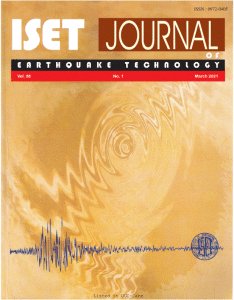Home > Issues & Journals
SEISMIC PERFORMANCE ASSESSMENT OF REINFORCED CONCRETE STRUCTURES WITH MASONRY INFILLED PANELS. THE CASE OF BLOCK # 22 OF THE SANTA MARIA HOSPITAL, IN LISBON
J. Proença, Carlos S. Oliveira and J. P. Almeida
Paper No.: 449
|
Vol.: 41
|
No.: 2-4
|
December, 2004
|
pp. 233-247

Abstract
Early, pre-code, reinforced concrete structures present undetermined resistance to earthquakes. This situation is particularly unacceptable in the case of essential facilities, such as healthcare structures. Amongst these, the Santa Maria Hospital – finished in 1953 with a total area of 120 000 m2 – in Lisbon, was designed without explicit consideration for earthquake loading. Given the crucial importance of this healthcare facility in the case of a strong earthquake in the greater Lisbon metropolitan area, the Portuguese Health Ministry requested a seismic vulnerability assessment of the Hospital structure, as well as of the major non-structural components, medical equipment and basic infrastructure lifelines
The structural seismic vulnerability assessment stages comprised the development of linear dynamic and nonlinear static numerical models for some of the more representative building blocks. Nonlinear static analyses were conducted on one of the Hospital’s most representative buildings according to displacement-based seismic design methodologies, as recommended by FEMA-273 (BSSC, 1997) and ATC-40 (ATC, 1996). A first nonlinear model was significantly modified through the introduction of diagonal struts, representing the stiffening effect of infill masonry walls, to match the experimentally determined fundamental frequencies. The analysis was carried out by means of two distinct nonlinear models, in terms of the load patterns. The first model (as described above) was used until all struts at a given intermediate storey collapsed, leading to a substantial change in the deformation and load pattern. The subsequent second model differed from the first model by the removal of the struts that had collapsed. A sensitivity analysis was carried out by changing the strength parameters of the diagonal struts. The final capacity curve was computed combining the former two capacity curves, and the performance point was subsequently estimated through the Capacity Spectrum Method (CSM). The results show that the structure does not collapse but the high damage concentration in the intermediate storey renders the building partially inoperative.
Keywords: Performance-Based Design, Seismic Assessment, Masonry Infilled Structures, Healthcare Structures, Modal Identification
©2025. ISET. All Rights Reserved.